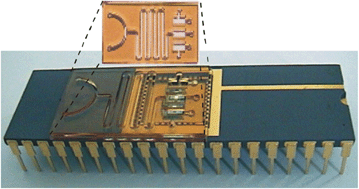A lab-on-a-chip for spectrophotometric analysis of biological fluids
Abstract
This paper reports a lab-on-a-chip for application in clinical analysis, especially in the spectrophotometric analysis of biological fluids. It is composed of three parts: (1) a microfluidic system die containing the microchannels fabricated using SU-8 techniques; (2) an optical filtering system based on highly selective Fabry–Perot optical resonators using a stack of CMOS process compatible thin-film layers; (3) a detection and readout system fabricated in a CMOS microelectronic process. The system enables low-cost and selective measurement of the concentration of several biomolecules in biological fluids. Operation is based on optical absorption in a well-defined part of the visible spectrum, defined by the reaction of a specific reagent with a specific biomolecule. Signals proportional to the intensity of the light transmitted through the biological fluid are available at the output in the form of bit streams, which allows simple computer interfacing. Moreover, the optical filtering system enables the measurement using white light illumination, thus avoiding the use of a wavelength dependent light source. This characteristic makes the lab-on-a-chip portable and ensures that the analysis can be performed at any location with instantaneous results, without the use of complex and expensive analysis systems. The quantitative measurement of


 Please wait while we load your content...
Please wait while we load your content...